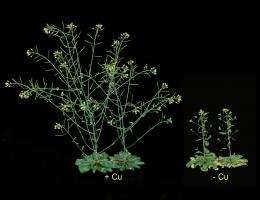How plants absorb the perfect quantity of minerals

In order to survive, plants should take up neither too many nor too few minerals from the soil. New insights into how they operate this critical balance have now been published by biologists at the Ruhr-Universität in a series of three papers in the journal The Plant Cell. The researchers discovered novel functions of the metal-binding molecule nicotianamine. "The results are important for sustainable agriculture and also for people – to prevent health problems caused by deficiencies of vital nutrients in our diet" says Prof. Dr. Ute Krämer of the RUB Department of Plant Physiology.
All organisms need iron, zinc, and copper as nutrients. They contribute to the essential catalytic functions within the cell. Because plants are at the beginning of the food chain, sufficient content of these minerals in them is essential for the human diet. These metals are chemically very similar, making it difficult for organisms to distinguish between them.
The metal-binding molecule nicotianamine is important for iron transport in plants. In her time at the universities of Heidelberg and Bochum, Krämer has demonstrated that it also makes a major contribution to the zinc balance. "Too much zinc can poison iron-dependent processes and vice versa" the biologist explains. How much zinc is available in the cytosol depends on where the nicotianamine is stored in the cell. The membrane transport protein Zinc-Induced Facilitator1 (ZIF1) can move the metal-binding molecule from the cytosol to the vacuole – a separate area of the cell which stores substances, among other roles. Given high zinc concentrations in the cytosol, ZIF1 transports nicotianamine into the vacuole. As a consequence, zinc ions are also transported into the vacuole and thus removed from the cytosol and the internal transport routes of the plant. The zinc is now less competition for the iron, so that iron is more readily available in the cell.
For genetic reasons, plants contain very different amounts of minerals depending on their living environment. Arabidopsis halleri, for example, which is native to Germany, gathers a hundred times more zinc in its leaves than many other plants. In cooperation with colleagues from the University of Bayreuth, Krämer's team has contributed to showing how this functions: Arabidopsis halleri produces large amounts of nicotianamine. When the researchers deactivated the synthesis of this molecule by means of genetic manipulation, the plants also transported less zinc from the roots to the leaves. Nicotianamine is therefore crucial for the high zinc concentration in leaves. "In developing countries, zinc deficiency is one of the biggest dietary risk factors for health problems" Krämer explains. "Our data may provide important clues on how to breed crops with increased zinc content".
The Bochum biologists also researched how plant cells absorb copper together with American colleagues. For this, they employed what is known as next-generation sequencing. The method they employed simultaneously decodes all messenger RNAs within a cell. This gives a complete picture of what proteins the cell should produce in what quantities. From these data, Krämer's team identified new molecules with a critical role in the absorption of copper. The scientists demonstrated that the copper ions are first converted from the double positively charged cupric to the single positively charged cuprous form, which is essential for the following absorption in the plant. Two specific enzymes, called copper reductases, are responsible for this. "Independently of this, we have also discovered that copper deficiency in plants triggers a secondary iron deficiency – contrary to previous expectations, and very similar to human metal metabolism".
More information: M.J. Haydon, M. Kawachi, M. Wirtz, S. Hillmer, R. Hell, U. Krämer (2012): Vacuolar nicotianamine has critical and distinct roles under iron deficiency and for zinc sequestration in Arabidopsis, The Plant Cell, doi: 10.1105/tpc.111.095042
U. Deinlein, M. Weber, H. Schmidt, S. Rensch, A. Trampczynska, T.H. Hansen, S. Husted, J.K. Schjoerring, I.N. Talke, U. Krämer, S. Clemens (2012): Elevated nicotianamine levels in Arabidopsis halleri roots play a key role in zinc hyperaccumulation, The Plant Cell, doi: 10.1105/tpc.111.095000
M. Bernal, D. Casero, V. Singh, G.T. Wilson, A. Grande, H. Yang, S.C. Dodani, M. Pellegrini, P. Huijser, E.L. Connolly, S.S. Merchant, U. Krämer (2012): Transcriptome sequencing identifies SPL7-regulated copper acquisition genes FRO4/FRO5 and the copper dependence of iron homeostasis in Arabidopsis, The Plant Cell, doi: 10.1105/tpc.111.090431
Provided by Ruhr-University Bochum
















